Last Updated on March 15, 2025 by Kittredge Cherry


Jesus praised a gay centurion in the Roman army as a model of faith and healed his male lover in the gospels, according to some Bible experts.
The centurion’s story has gotten surprisingly little attention throughout history considering that Jesus himself was impressed by his faith. But the Roman soldier has always been an unlikely role model. Jesus’ contemporaries were probably shocked that the great healer would praise a military man who enforced Roman occupation of their land. Today people may find the centurion unappealing because he may have been queer, or a slave owner, or both. It was just like Jesus to take someone disreputable and praise them as holy.
Both Matthew 8:5-13 and Luke 7:1-10 tell how a centurion asked Jesus to heal the young man referred to in the original Greek as his “pais” (παῖς). The word was commonly used for the younger partner in a same-sex relationship. It is usually translated into English as boy, servant or slave. In recent years progressive Bible scholars have concluded that the centurion was in a homosexual relationship with the “slave who was dear to him” in the gospel story — in other words, his boyfriend. However being gay today implies an egalitarian relationship, while the centurion and his pais were obviously unequal male partners, as was common at the time.
The story of the centurion is read every year in Roman Catholic churches on the first Monday of Advent (Dec. 2, 2024). Some call it “Gaius and Basanius Monday.” The centurion is unnamed in the Bible, but LGBTQ tradition has given him the name Gaius, emphasizing his connection to the gay community. The name Basanius is proposed for his lover because in Greek the gospel says that he was “basanizomenos” (βασανιζόμενος) or “tormented.” The centurion is assigned to odd dates that rarely come up in the lectionary used by Protestant churches,
 Q Spirit also highlights the centurion and his servant on March 15 for the feast day of Longinus, a centurion at the crucifixion of Jesus. Longinus pierced Christ’s side at the crucifixion and declared, “Truly this man was the son of God.” It’s possible that he is the same faithful gay centurion whose beloved boyfriend was healed by Jesus.
Q Spirit also highlights the centurion and his servant on March 15 for the feast day of Longinus, a centurion at the crucifixion of Jesus. Longinus pierced Christ’s side at the crucifixion and declared, “Truly this man was the son of God.” It’s possible that he is the same faithful gay centurion whose beloved boyfriend was healed by Jesus.
“Healing the servant of the Centurion” is a fresco from 1547 at Dionysiou Monastery, an Eastern Orthodox monastery on Mount Altos in Greece
A centurion was a Roman commander in charge of approximately 100 soldiers. They probably spoke their local language and Latin, the official language of the Roman military. In Luke’s account, the centurion sends Jewish elders to speak to Jesus for him. Jews generally resented and resisted the Roman occupation forces, but the elders told Jesus that the centurion deserved his help because he treated the local community unexpectedly well, even helping build their synagogue.
The centurion asks Jesus to help because his servant is in physical and mental agony: paralyzed and “tormented.” Jesus was willing to go into the centurion’s house to heal his lover, but the centurion stopped him, saying, “Sir, I am not worthy to have you come under my roof. But just say the word, and my servant will be healed. For I myself am a man under authority, with soldiers under me. I tell one to go, and he goes; and another to come, and he comes. I tell my servant to do something, and he does it.” During the coronavirus pandemic, this long-distance method might be called “social distancing.” Jesus saw it as an act of great faith.
Jesus marveled and told the crowd around him, “Not even in Israel have I found such faith!” To the centurion he said, “Go; be it done for you as you have believed.” And his boyfriend was healed at that moment.
While the faithful centurion himself is rarely mentioned, his words do live on in a prayer used in many Catholic and Protestant eucharistic liturgies. For example, every day millions of Catholics around the world echo his words in the prayer immediately before communion at Catholic mass: “Lord I am not worthy to receive you under my roof, but only say the word and my soul shall be healed.”
New in Dec 2024: Icon shows embrace of centurion and his servant
 A new icon presents the centurion and his servant in way that they may never have been seen before: Both men appear healthy, arms around each other in a loving embrace, in an icon by artist Tobias Haller. They gaze directly at the viewer with pride, perhaps even defiance. The gleam of the Centurion’s armor is matched by the sheen on the skin of his shirtless “servant” or in the original Greek of the New Testament, his “pais.” This much-disputed word is written in Greek next to him. The centurion or ἑκατόνταρχος (hekatontarchos) is also labeled in Biblical Greek. The icon appears at the top of this post.
A new icon presents the centurion and his servant in way that they may never have been seen before: Both men appear healthy, arms around each other in a loving embrace, in an icon by artist Tobias Haller. They gaze directly at the viewer with pride, perhaps even defiance. The gleam of the Centurion’s armor is matched by the sheen on the skin of his shirtless “servant” or in the original Greek of the New Testament, his “pais.” This much-disputed word is written in Greek next to him. The centurion or ἑκατόνταρχος (hekatontarchos) is also labeled in Biblical Greek. The icon appears at the top of this post.
Haller is an iconographer, author, composer, and retired vicar of Saint James Episcopal Church in the Bronx, still assisting at a parish in Baltimore, Maryland. Haller enjoys expanding the diversity of icons available by creating icons of LGBTQ people and other progressive holy figures as well as traditional saints. His artwork appears frequently on Q Spirit.
Centurion’s story can affirm LGBTQ people
Scholars believe that “boy” was the centurion’s sex partner not only due to the word “pais,” but also because it is unlikely that a soldier would care so much about an ordinary slave. It was common in Greco-Roman culture for mature men to pair up with a young man as his lover in “erastes-eromenes” pederastic sexual relationship.

This interpretation is promoted by LGBTQ-friendly church groups such as WouldJesusDiscriminate.org on billboards stating “Jesus affirmed a gay couple.” For more info, see my previous post, Billboards show gay-friendly Jesus.

An 1839 copper engraving of the Centurion asking Jesus to heal his servant appears in “Miller’s Scripture History,” published by J. Rider. An original print was available at Amazon. The poem below the image reads: “Christ to Capernaum takes his way: There a Centurion comes to pray, If on the Lord he may prevail To come, and his sick servant heal.”
Scholars also note that any relationship between an adult soldier and his “boy” or “slave” is inherently asymmetrical, not a partnership of mutual equality. Christopher B. Zeichmann, New Testament instructor at the University of Toronto, writes about it as “a text of queer terror” in the context of “the rape culture of antiquity.”
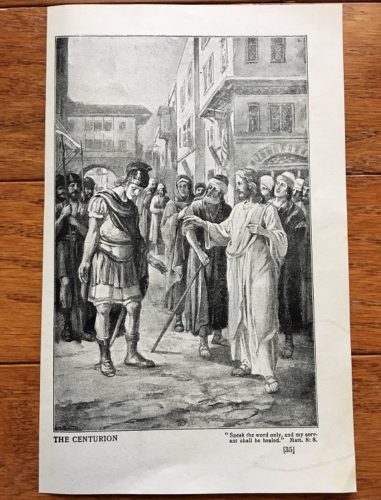
The centurion says, “Speak the word only, and my servant shall be healed” in a page from the 1914 edition of Bible Readings for the Home Circle. The original page was available at the Things Are So Lovely shop on Etsy.
Artists and writers portray the gay centurion
Artists have also tended to overlook the gay centurion’s story. Vintage Bible books are a good place to find images of the centurion asking Jesus to heal his “servant.” Some contemporary LGBTQ artists are also presenting the scene.
“Centurion and his Pais” by Aaron Holloway appears at the top of this post. The mixed emotions of homoerotic love between a soldier and his servant are expressed with stark clarity in the photo by Holloway, an Australian photographic artist living in Germany. The inequality of their social positions is expressed in their physical stance: The centurion sits on a chair in his armored military uniform, minus the helmet, with one hand on his sword and the other hand caressing his lover’s head. The nearly naked pais rests on the floor with his head in the centuion’s lap. He clings to the centurion’s ankle, but the glum expression on the face of the pais suggests that he may be a less than enthusiastic participant in their sexual games — or perhaps he is just sick and in need of healing. Holloway’s work is online at adavidhollowayart.com.
A Bible quote appears in the rainbow colors of the LGBTQ Pride flag behind Jesus and the centurion in a 2022 artwork by Gustavo Daguerre of Argentina.

Jesus and the Centurion by Gustavo Daguerre
The scripture is a Spanish version of the centurion’s words to Jesus in Matthew 8:8: “Lord, I am not worthy to have you come under my roof, but only say the word, and my servant will be healed” (Señor, no soy digno de que entres en mi casa, pero una palabra tuya bastará para sanarle.) The image was added to Q Spirit in 2023 for the centurion’s feast day.

“Rainbow Centurion and Jesus” by Jeremy Whitner
In a colorful 2022 painting by queer Christian iconographer Jeremy Whitner, the centurion has a rainbow halo to indicate his connection to the LGBTQ community as he asks Jesus to heal his same-sex lover. Jesus also has a rainbow halo, inspired by the Rainbow Christ Prayer that reveals the many faces of the queer Christ. Whitner is in process for ministry with the Disciples of Christ and attends Union Presbyterian Seminary in Charlotte, North Carolina.
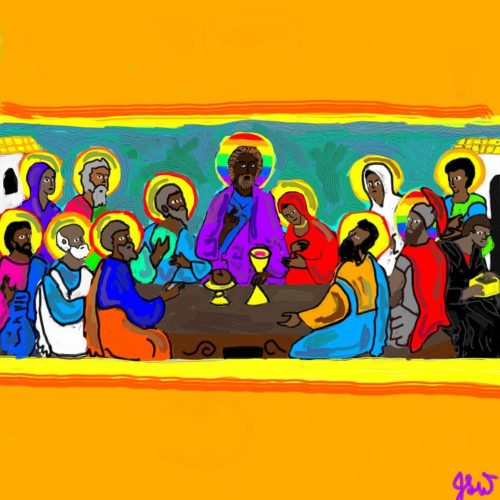
“Do This in Remembrance of Me” by Jeremy Whitner includes the centurion with a rainbow halo.
The centurion appears again in Whitner’s vision of the Last Supper. He places the centurion is among the disciples in “Do This in Remembrance of Me.” The centurion can be identified by his rainbow halo and the red crest on top of his helmet. It’s unusual to picture the centurion at the Last Supper, but Whitner believes he joined the other disciples at the Passover meal because of his faith in Jesus. “When I consecrate communion I always make of point of saying the centurion was probably there, along with the woman with the issue of blood,” Whitner told Q Spirit.
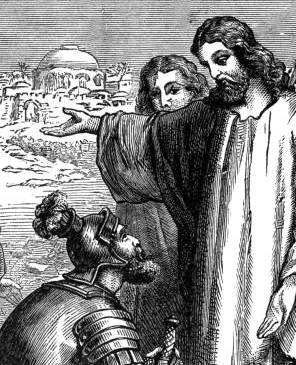
Detail from “Healing the Centurion’s Servant” in Mother Stories From the New Testament by Anonymous, 1906
Gay New Zealand artist Christopher Olwage pictures the centurion and his “pais” with Jesus at the cross in his 2015 crucifixion painting. The scene is framed by a male couple: the centurion on the left and the man “who was dear to him” on the right. The nude painting includes two other men who may have had male-male sexual relationships with Christ: John, who is most often identified as the Beloved Disciple and Lazarus. For more info, see the previous post Gay Jesus painting shown in New Zealand.

“Crucifixion” by Christopher Olwage (oil on canvas)
Jesus’ healing interaction with the same-sex couple has fascinated artist Eric Martin so much that he created two works based on their story. Martin (1960 – 2017) was a gay poet, artist, and church organist in Burlington, North Carolina. He earned a Master of Divinity degree from Southeastern Baptist Theological Seminary in Wake Forest, NC.
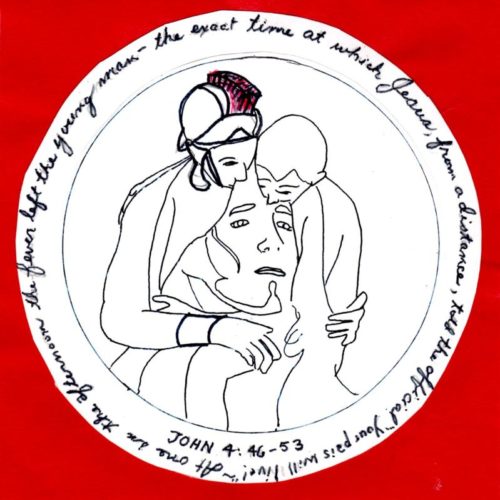
“Traces of His Presence” by Eric Martin
“Traces of His Presence” uses fluid lines and bold red to reveal the face of Christ in the holy space between the centurion and his beloved.
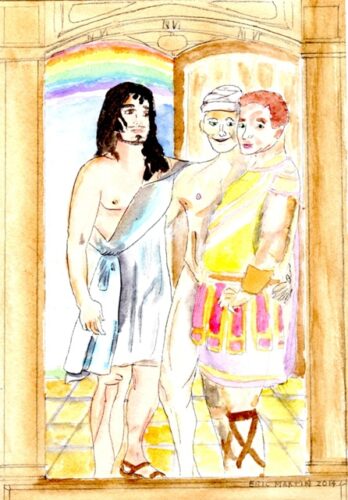
“The Visit” by Eric Martin
Martin takes a more realistic approach in “The Visit.” A rainbow arches behind Jesus as he gazes at the centurion and his pais. Their varied expressions draw the viewer deeper into the drama.
Sexual expression of a centurion’s love for Jesus is also the theme of “The Love That Dares To Speak Its Name” by British writer James Kirkup, the poem that led to a notorious trial and the last blasphemy conviction in Britain. Written from the viewpoint of a centurion, it graphically describes him having sex with Jesus’ corpse after his crucifixion and claims that Jesus had sex with other men, including his disciples, guards and Pontius Pilate. Gay News published the poem in 1976 and its editor, Don Lemon, became the last person convicted of blasphemous libel on July 11, 1977. Since then the poem has been made available by other publishers and public readings, but it is still technically illegal to publish the poem in the United Kingdom.
The centurion speaks his queer love and faith this way in the last lines of the poem:
And after three long, lonely days, like years,
in which I roamed the gardens of my grief
seeking for him, my one friend who had gone from me,
he rose from sleep, at dawn, and showed himself to me before
all others. And took me to him with
the love that now forever dares to speak its name.
Books that explore the homosexuality of the gay centurion
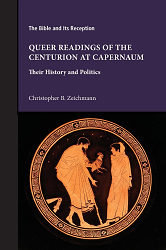
“Queer Readings of the Centurion at Capernaum: Their History and Politics” by Christopher Zeichmann.
LGBTQ interpretations of Jesus healing a soldier’s boyfriend are explored in this scholarly book. It documents 40 years of homoerotic readings of the Bible story, but this is the first full book devoted to the subject. The queer approach is based on translations of the Bible passage about the “pais” or young man who was “dear” to the centurion and the prevalence of homosexuality in the Roman army. The monograph traces how homoerotic readings of the scripture have evolved since the 1950s based on sexual, political and theological trends. It includes a helpful appendix with a chronology of homoerotic readings from 1950-1989. The author teaches New Testament at the University of Toronto and Toronto Metropolitan University in Canada. Published by SBL Press (Society of Biblical Literature) in 2022.
Jonathan Loved David: Homosexuality in Biblical Times by Tom Horner
Freedom, Glorious Freedom: The Spiritual Journey to the Fullness of Life for Gays, Lesbians, and Everybody Else by John McNeill
The Children Are Free: Reexamining the Biblical Evidence on Same-sex Relationships by Jeff Miner and John Tyler Connoley
What the Bible Really Says about Homosexuality by Daniel Helminiak
The Man Jesus Loved: Homoerotic Narratives from the New Testament by Theodore Jennings
“Queering My Religion: Biblical Stories of Queer Love In The 90’s” by Jeff Crim is a short-story collection where Bible stories are re-imagined through a queer lens in the 1990s Midwest. Fictional characters connect the 20th-century with four scriptural narratives that are favorites of the LGBTQ community, including the centurion and his boyfriend. Based in Tennessee, the author is an ordained minister in the Evangelical Lutheran Church in America (ELCA). Independently published, 2024.
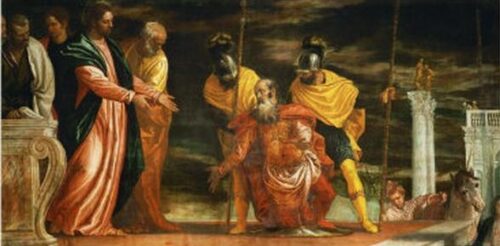
“Jesus Heals a Centurion’s Servant” by Paolo Veronese (1528-1588) (Wikimedia Commons)
Prayers
Q Spirit’s Litany of Queer Saints includes this line:
“Faithful centurion, whose boyfriend was healed by Jesus at your request, pray for us!”
Links related to the gay centurion
A gay centurion comes out to Jesus (Gay Christian 101)
Jesus and the centurion (Wild Reed)
Gay centurion (My Queer Scripture)
Jesus, the centurion, and his lover (Jack Clark Robinson at Gay and Lesbian Review)
When Jesus Healed a Same-Sex Partner by Jay Michaelson (Huffington Post)
“The Centurion’s Servant” painting by British artist Stanley Spencer, 1914
El centurión gay: Jesús cura al novio de un soldado romano en la Biblia (Santos Queer)
Oratio ad Christum Iris (Rainbow Christ Prayer in Latin)
___
Top image credits:
“The Centurion and His Servant from Matthew 8” by Tobias Haller, 2024.
“Centurion and his Pais” by Aaron Holloway. His work is online at adavidhollowayart.com and saatchiart.com/A.DavidHollowayArt.
___
This post is part of the LGBTQ Saints series by Kittredge Cherry. Traditional and alternative saints, people in the Bible, LGBTQ martyrs, authors, theologians, religious leaders, artists, deities and other figures of special interest to lesbian, gay, bisexual and transgender and queer (LGBTQ) people and our allies are covered.
This article has evolved and expanded greatly since the first version was posted in March 2012. It was published on Q Spirit in March 2017, was expanded over time, and was most recently updated on Dec. 2 2024.
Copyright © Kittredge Cherry. All rights reserved.
Qspirit.net presents the Jesus in Love Blog on LGBTQ spirituality.



















Thank you for this article. I am reading through this very Story and am so glad to have found your site once again. I Will be Sharing this with my church. Be blessed!
I read and feel sad at all these comments on here from the “so called Greek Scholars” who claim to know exactly what happened that day while condemning others. For me it is completely irrelevant whether the Centurion was “Gay” or not. When Jesus was asked to go to heal, he didn’t start questioning, “Is this a gay relationship”? He didn’t hesitate. He didn’t inquire as to the nature of their relationship. He was willing to go. Jesus went into all types of situations. When he was in the home of Simon the Pharisee and the prostitute came in as Jesus was reclining at the table, she wept at his feet and as she did her tears splashed down onto his feet, so she dried them with her hair. He was not disgusted by her. It was Simon the religious zealot that was disgusted. So much so he reasoned that of Jesus were truly a man of God then he would know what type of woman this was and push her away. Jesus corrected his erroneous thinking in one of the most beautiful accounts I have ever read. Jesus taught those who would listen to LOVE. Love God, Love our neighbor. Simple. No condemnations. No judgements, no hatred, just to LOVE. Those on here spewing their hatred for others while claiming to be Jesus lovers and all devout, should hang their head in shame for you learn nothing from the man you profess to follow. Whether the Centurion and his servant had a relationship or not was irrelevant to Jesus. It was his expression of Faith that was the lesson. Jesus made no judgement or laid down any conditions, he was just ready to show love. If we claim to follow him then we need to do the same.
Mike Kent — Agreed; and thank you for this thoughtful comment.
The sexual orientation, the profession, and other aspects of a supplicant’s life were irrelevant in these examples. And in the two most important commandments (Love God with everything you are, and love others as you love yourself), we can see this subtext: Know yourself (so you can love God with all of yourself), and love yourself (otherwise the second commandment makes no sense).
When we condemn someone instead of loving them, we make it harder for them to follow these commandments themselves—in particular, the second, for the condemnation of others can interfere with our ability to love ourselves. Surely, this is sin.
Nobody is making judgements or setting conditions. Jesus didn’t praise the centurion for his homosexual relationship, he praised him for his faith. That’s *all* you need to know about it. That’s why it doesn’t matter if the centurion was homosexual or not. It’s still a sin, no matter how much you want to disagree with it.
Jesus helped *everyone* and *everyone* are sinners. Him helping them doesn’t excuse their sin. Thats where the LGBT community reveals their hate. They want to change God to fit their image, instead of changing their desires to fit God. ALL sexual activity outside of marriage is a sin. It doesn’t matter if it’s straight or gay, it’s still a sin. And ONLY a marriage between one man and one woman under God is valid, as it’s a reflection between Jesus’s marriage to the church. One groom and one bride. Not two grooms, not two brides.
You can keep trying to change God but that isn’t going to mean He actually does.
It’s a lovely fantasy story but I’m not sure your sources are correct. The text is such a loving beautiful miracle even if not gay.
It was his son not his boyfriend. Can’t copy and paste scripture to make it what you want.
As others here have already noted, the idea that the centurion’s “pais” was his “boyfriend” has no basis in the original language, and even you allude (somewhat indirectly) to the fact that the only possible homosexual interpretation would be if you interpret it as a boy or sex-slave in a pederastic relationship (which you delicately describe as “the younger partner” but in reality it would be a boy or slave used for sex, not a younger man in an equal relationship). But the reason “it is usually translated as boy, servant or slave” (as you note) is because it usually meant one of those things (along with “son”) and only rarely referred to a boy being used sexually. So any possible interpretation of the language would run counter to the manner in which you’re using it here: it either has nothing to do with a sexual/romantic relationship at all, or it refers to a pedophile abusing a little boy or slave.
I thought it was very interesting that my oldest Strongs Concordance explicitly mentions and cites the Koine usage of the male lover among others. When it wore out and I pitched it for a new one. Was surprised absolutely no reference to the Koine use of pais as male lover is cited whatsoever. Guess they had to toe the line for the fundamentalist book sellers .
So I kept searching and searching, but none of what you said was a defense of homosexuality. It is described as a sin, both in the old testament and the new testament. Jesus didn’t praise the centurion for his homosexuality. He didn’t praise the centurion for his sin. He praised the centurion for his faith, because the man had faith in the power that Jesus proclaimed to have as the Son of God. That centurion was still a sinner as are we all.
Constantly we see this push to justify or accept certain sins in order to make Christianity fit into a leftist worldview. That is literally creating a false god for you to worship, one made in your own image and your own ideals. Everyone is a sinner. It is endemic to who we are. Jesus was the only person who was ever without sin. But LGBT people are adamant about reveling in and taking pride in their sin. I struggle with anger and rage. That’s as much a part of me as gay people wanting to have sex with the same gender. The only difference is I don’t have pride in my sin. I know I’m a sinner, and I know I don’t deserve to go to heaven. Humility is a virtue for a reason.
You need to read other Biblical commentaries that were done by genuine intellectual scholars. There have been great strides in Biblica studies as we can put these events in historical context. I think in 100 years you and all of us will make more sense in our historical context.
Whether the story of the centurion does or does not describe what we would see today as a loving, homosexual relationship, the reasons it might have been condemned two thousand years ago in Judea are no longer viable today. For example, as documented by the late theologian Dr. Walter Wink, people at that time and in that place were convinced that all the essentials for human life were contained in male ejaculate. Therefore, any male sexual release that didn’t take place where conception could occur was abomination (that is, against tradition). Masturbation, bestiality, oral sex, and homosexuality all fall into this murder-adjacent category, and all are condemned by people who have that misunderstanding. And even if we believe Jesus had known that one day we would know better, he couldn’t say that two thousand years ago, or he’d have been either locked up as a madman or ignored. His mission was too important to risk that.
Was it a sin for Lot to impregnate both his daughters? If Yahweh God had a problem with that, he didn’t even click his tongue. Both these girls’ sons went on to become heads of tribes (Gen 19:37-38). It seems clear that some sin/morality is crystalized within a specific time and place.
To allow anger and rage to take hold in you prevents you from coming from a place of love, which is supposed to be the lesson Jesus teaches. It’s clear you have a very limited understanding of sexual orientation. I hope you will seek information that helps you understand and, in consequence, assuage your fear, which is the true source of anger and rage.
As an exchristian who is also wants to defend LGBTQI+ people at every opportunity, I don’t think people should be looking to the Bible for that defence and I think the interpretation above is eisegetic at best. παῖς is commonly used in Greek literature, in the Bible and commonly outside of it (from Aeschylus), simply to denote children or servants (presumably the root is because of the small stature of the servant, the asymetric balance of power).
While you could make an argument hypothetically about them being in a relationship based on Greco-Roman colture or whatever, it’s impossible to make that argument on the text of Matthew (or indeed Luke). Pais does not necessitate the reading made above, it’s a reading projected onto the text that’s impossible to verify historically or exegetically.
I personally think the Bible is an archaic text like so many others in history, that carries the prejudices of its time mixed with myth. I understand why many queer people want to hold on to it, and I don’t want to dispell them of that unless they want to. But I DO think any attempt to defend LGBTQI+ positions on the basis of the Bible on passages like the above is going to fail when taken to evangelicals. Because, in this case, they’re right. The argument can’t be borne out by the text when subjected to historico-critical analysis.
Centurions were not allowed to marry whilst in the Roman army. They retired at c.40 or were invalided out. They often had, what today might be called “common law” wives – and children by them. As the “wives” were often slaves (picked up on their travels), their own children were slaves! On retirement a Centurion would marry the woman and adopt his own children. Before this his children were “Pais” – both his children and slaves. Nothing to do with homosexuality.
This is incorrect the original Greek word for servant is phis (pronounce paheece). which means a child, boy or youth
Usage as it actually means in Matt 8:8 Is a male slave nothing more
Via the bible hub app- looking at Greek translation
So no jesus did not condone a gay relationship.
Thus you are using this whole point out of context
In my opinion it is not an outrageous meritless conclusion nor represents a possibility that can be removed or disqualified by any power or effort to limit or define what Pais means or that it strictly had a single application pertaining exclusively to a single kind of relationship. The culture of that time is historically recorded in multiple sources that it was common practice among the Romans and Greeks of that time for men of wealth and power to accept young men into their households. The young men in this context are also more often than not referred to as Pais. And regardless of you you may individually feel about whether it was appropriate, it is also recorded repeatedly and consistently from multiple sources that sexual relationships between Pais and their Masters were a common occurrence. To deny this goes against what is clearly supported as a factual reality in history. The fundamental problem here I see and must point out is there is no legitimate method which can be used to classify or describe what the true dynamic of the relationship mentioned in that scripture really represented. Unless we were there in that time and had intimate personal knowledge or familiarity with the Centurion and that particular Pais there are no conclusions or interpretations that can be made which meet criteria establishing them as fact. Any effort to do so is tainted by a filter of individual bias and interpretation of insufficient data and detail that may inspire theories or lead to a conclusion but not as a fact to justify hatred nor validate a sexual preference. To attempt to do so defies any definition of rational thought or judgement and feels like a dangerous attempt to manipulate history to justify an agenda. The best anyones can say no matter how many degrees or educational credentials in theology or history they possess is that the relationship is a possibility based on common practice occurring in that time. Nothing more. We should ask ourselves why it is so important to us and what we represent that we will resort to the invention of narratives based on our perception of what the imply and represent them as credible representations of fact. What would happen if we put the same amount of energy into empathy, love and compassion for one another?
FYI- this teaching is not from the Bible. Below is the word study from the original Greek word pais and some other references where used scripture.
παῖς pais slave; servant; child
LSJ
Lexham Theological Wordbook boy, servant, child.
DBL Greek child; child; slave
EDNT servant; child, son
LXGRCANLEX slave; servant; child; child; boy; son; slave; child
Subject
Mt 8:6
Mt 17:18
Jn 4:51
Object
Lk 9:42
Ac 3:13
Mt 2:16
Lk 12:45
addressee
Lk 8:54
Indirect Object
Mt 14:2
The lesson in the healing of centurion’s servant was linked to faith which ultimately came from his understanding of authority. When Christ and His commands are our ultimate authority, we have greater faith, we trust Him and His plans for us. The soldier knew his real identity, he had authority over men, but came under the authority of God. The surrender of our will is essential to following Jesus. We must come under His authority and find our identity in Him.
“If anyone wants to come after Me, he must deny himself, take up his cross daily, and follow Me.” Luke 9:23
I am just shocked that his article even exist, that someone would make a claim that Jesus healed the mans “Boyfriend”, because this is simply not true. In all bible versions it says “Servant”.
The Centurion has a lot of servants and he is a man of authority, and there is nothing wrong about him asking Jesus in total faith, to heal a man that is “paralyzed and in dreadful torment.”
The fact that thousands of people brought their sick to Jesus for healing was well documented and this Centurion saw the power Jesus had in healing sick. So he asked for a person he knows,(his servant) to be healed as well. There is no need for speculation “was this his male lover”. This article just shows that we truly live in the end times. Where people will twist the truth to fit their own desires.
I believe so many here, are missing the point. People in marginalized communities need hope, they need to believe that the God that created them is the same God that embraces them. That shouldn’t be too much of a stretch for good Christians to comprehend. If you take away hope and you impose judgment then you too have manipulated scripture for your own purpose of controlling and driving hate, which is not what Jesus taught. The exclusion of entire groups of God’s children from mainstream faith traditions is an abomination and I pray for all those who have acted in contradiction to the teaching and modeling of our savior. Judge as you have done since before Christ, condemn as Christ’s accusers condemned but ONLY GOD has the right to judge which you take upon yourself. Scripture has been bastardized and white washed and it is far from the original text but it is easier to believe a version that is in-line with your hate mongering.
How can pais mean male lover when Jesus is called a pais in Matthew 12:18?
“That’s a good question”. The Greek word pais carries a range of meanings depending on the context in which it is used. Pais can refer to an infant, a child, a boy, a girl, a servant, a slave, an attendant, a King’s attendant, a minister or a male lover.
When we see the word pais in the Greek New Testament, context determines when it means child, servant, girl, boy or a male lover. Words do not always mean the same thing. The fact that the Greek word pais sometimes means same sex lover does not indicate it always carries that meaning.
The context of Matthew 12:18 does not indicate that Jesus is a same sex lover. The context indicates Jesus is the servant of Jehovah, based on the fact that Matthew is quoting Isaiah 42:1-3, where Isaiah says: Behold, my servant.”
“If “pais” means a male lover, why was this same word used in Matthew 12:18 when referring to Jesus? I looked at Strong’s Concordance and noticed that the exact same word, “pais”, is used in both verses (the other verse being the one you refer to about the Centurion).”
Shalom and blessings to all
Jesus’ praise of the centurion for his great faith should not glibly be understood to be praise of homosexuality.
The condition of miracles, as pronounced by the Lord, is Faith on His name. Thus, Faith precedes miracles. Faith being the first principle of His “gospel” leads unto repentance.
To conclude that Jesus affirms homosexual relationships simply because he healed a boy who was possibly the sexual servant of this centurion would not be responsible.
Can a homosexual have great, even surprisingly great, faith?
Yes, of course.
All men are sinners and yet have the ability to exercise great faith in the Lord.
The type of sin we engage in does not bar us from exercising faith does it? For it is by faith on His name that we are brought unto repentance.
The world gets repentance all wrong.
The Lords gospel was to call all men to have faith, repent, be baptized in his name, and receive the holy ghost.
Did he preach this in anger or judgement?
No, it was with love.
Thus, His attention to the physical needs of this boy on behalf of his centurion master (whether homosexual or not) had but one purpose… to demonstrate His immense love for them. This love always having the purpose of motivating us to repent and follow him.
That homosexuality is a sin is beyond doubt to anyone doing an honest study of the scriptures. We should stop trying to justify our own sin. However, we should also stop judging the sin of others… To say that homosexuality is a worse sin than any other sin under the sun is not true. We all sin and we all need Jesus.
We can all learn from the Saviors example of love and kindness. Repentance is only motivated by love. Love is the most powerful thing in the universe. May we all pray God grant us with a portion of His divine love.
Very wise comment.
GOD’S nature is good.
This illustrates how much good He is Jesus didn’t condemn the centurion knowing full well he was living in sin.
Jesus healing the centurion servant is in no way condoning sin.
Jesus cant help but be good.
Well, ACTUALLY homosexuality is not expressed as a sin by Jesus but only in the old testament which is widely known to be mistranslated, and then by Paul who became a disciple only after Jesus ascended into heaven so he was never thought of by the Lord. Sin however is nonmarital sex. Which anyone can commit regardless of sexuality. But loving someone even when they are the same sex/gender as you is not sinful. Love isn’t sinning. We find this out in 1 John 4:16 it says God is Love. So any true act of love is not sin but an act of God. So homosexuality is no sin. Thank you for trying though.
You have added bias to your premise. The word Pias is used 24 times in the NT and is never translated same sex lover. The word pias can mean same sex lover in Koine Greek, but it is not used this way in the NT. This premise is not corroborated in scholarly exegesis.
Also, –in Matthew 19. Jesus explaining God’s plan for male and female sexuality.
Some Pharisees came to Jesus, testing Him and asking, “Is it lawful for a man to divorce his wife for any reason at all?” 4 And He answered and said, “Have you not read that He who created them from the beginning made them male and female, 5 and said, ‘For this reason a man shall leave his father and mother and be joined to his wife, and the two shall become one flesh’? 6 So they are no longer two, but one flesh. What therefore God has joined together, let no man separate.” 7 They said to Him, “Why then did Moses command to give her a certificate of divorce and send her away?” 8 He *said to them, “Because of your hardness of heart Moses permitted you to divorce your wives; but from the beginning it has not been this way. 9 And I say to you, whoever divorces his wife, except for immorality, and marries another woman commits adultery.”
10 The disciples said to Him, “If the relationship of the man with his wife is like this, it is better not to marry.” 11 But He said to them, “Not all men can accept this statement, but only those to whom it has been given. 12 For there are eunuchs who were born that way from their mother’s womb; and there are eunuchs who were made eunuchs by men; and there are also eunuchs who made themselves eunuchs for the sake of the kingdom of heaven. He who is able to accept this, let him accept it.” Matthew 19:3-12
Which version of the Bible are you citing? If you’re citing the New International, I’m not sure that you can really discredit her for bias since it was published in 1978, where bais against homosexuality ran rampant. The older the source, the more accurate. Both NKJ and NIV are very recent in terms of history and also have taken some pretty immense liberties to appeal to the masses. I doubt either of these are close at all to the original Word of God.
I adore the trap door in the floor that Jesus laid for biblical literalists to fall through when they cite his teachings on marriage to condemn homosexual unions. For Christ said not once, not twice, but three times in the gospels that remarriage after divorce for any reason except adultery IS adultery. Now, why would Our Lord feel it necessary to underscore so heavily this teaching about heterosexual unions if not that it was likely to be ignored? (And it is routinely and universally ignored except, ironically and more than a little hypocritically, by Roman Catholics, hardly the poster-church for biblical literalism.) Evangelicals might well prefer to pass over Christ’s teaching on hetero remarriage and adultery in silence—and certainly there is never one word preached about it by any mention of it by their leaders, neither from the pulpit, nor in the media—but since it presents such a stubborn conundrum, cropping up three times in the gospels, gays provide a convenient “oh shit, look over there!” source of diversion.
The much more important, glaring irony, however, comes when Jesus says Moses permitted divorce to appease the Jews’ “hardness of heart” even though it broke with established custom and law. In other words, their desire to be able to END loving unions and break up families brought about a change in how marriage was seen and practiced from the beginning of time. The desire of same-sex partners to CREATE families through their unions, the very opposite of hard-heartedness, is met with incredulity and disgust from the same Christians who are guilty of a much more prevalent, and serious sin.
Jesus didn’t just tolerate this gay centurion. He said he was an example of faith — someone we all should strive to be like.
We should all be gay! Take that homophobes
“Pais” in THIS context actually means “male servent” and it was the Centurions FAITH that was an example to be admired whereas the others needed contact, the Centurion said; “just give your Word” in which was a show of great Faith that Yeshua (Christ) would like to see others portray.
Who are we to judge others. Jesus teaches us to love and bear with one another. Nevertheless, we should condemn the action of the LGTB but pray for their repentance.
A. Okonkwo who are you to condemn any action. BY the Lord in Heaven most high is the only one to judge. The Word says it plainly to just LOVE not to condemn. We are all children who serve no authority to one another. We cannot judge or condemn actions done by other people. We care for our brothers and sister but when they do no wrong we can’t condemn them. Having love for another person is never wrong. Condemning anyone in the LGBTQ+ community is a sin. While I greatly disagree with your choice to condemn the beautiful creations of God I am in no position to judge or condemn you because that is our Fathers job, our Brother’s job. They have the authority to judge we are just their children.
Great works; I love the quality; The attention to beauty.